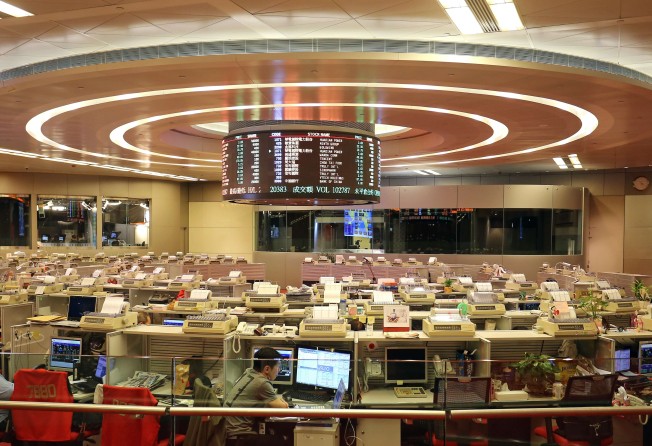Brokers believe Hong Kong stock market circuit breaker fails to address market’s real problem
Volatility control mechanism is unlikely to cause a repeat of Black Monday market meltdown in 1987 or China’s circuit breaker chaos in January, but some brokers say it is aiming at the wrong targets

On Monday, Hong Kong will introduce a circuit breaker system that suspends stocks for five minutes in the event of abnormal price movements. The impending launch has brought back memories of past failures and some brokers are questioning if its implementation is such a good idea.
Supporters believe the city should follow the international trend where major markets such as the United States and Britain use circuit breakers to cool the market amid sharp volatilities.
“It all depends on how you design the circuit breaker. It should be noted that Hong Kong’s system only suspends individual stocks from trading for five minutes and not the whole market,” said Benny Mau, chairman of the Hong Kong Securities Association.
“This is why Hong Kong’s stock market will definitely not repeat the chaotic scenes in China in January when the newly launched circuit breaker caused a market meltdown. The chaos in 1987 in Hong Kong would not have happened either.”
Looking back, Hong Kong’s most memorable market trading break was the four-day suspension that began on October 20, 1987, after Black Monday’s market crash, which led to many criticisms concerning settlements. Since then, except for extreme weather, the Hong Kong market has never closed for a whole day.
More recently, another nightmare happened when China launched its own circuit breaker in January. The Chinese system was designed to be triggered if the CSI300 index, which that tracks large cap stocks listed in Shanghai and Shenzhen, falls or rises by 5 per cent, bringing the whole market to a halt for 15 minutes. It would be suspended for the rest of the trading day if the rise or decline reached 7 per cent.
The system was so controversial that it was scrapped only four days after launch. But the damage was done. The following meltdown caused the Shanghai Composite Index to fall by 22.7 per cent, its worst monthly performance since October 2008. The Shenzhen Composite Index lost 28 per cent in January.
Mau said the problem with China’s circuit breaker was that the threshold had been set too low and was easily triggered. The closure of the entire market rather than the stock involved was another problem.
The 5 per cent threshold for China’s circuit breaker is lower than 7 to 13 per cent range used in the US which suspends the market for 15 minutes if such a movement happens. It would require a swing of 20 per cent for the whole US market to be closed for the day.
South Korea halts all trading for 20 minutes if a 10 per cent fall occurs.
China’s circuit breaker was one of the world’s most restrictive. Also in use is a price control rule that allows a stock to run up or down by only 10 per cent a day. South Korea’s price limit is 15 per cent and in Taiwan it moves within a range of 15 per cent to 50 per cent. In China, the circuit breaker may have been removed from the market, but the price control limits remain.
The Hong Kong stock market has no price controls and its soon-to-be launched circuit breaker system is also among the most relaxed worldwide.
The volatility control mechanism, as Hong Kong exchanges and Clearing officially calls it, applies to the 81 largest constituent stocks listed on the Hang Seng Index or the H-shares index.
It will suspend execution of a stock’s trading for five minutes, if it moves up and down 10 per cent in five minutes. Only one suspension is allowed in each of the morning or afternoon trading sessions.
HKEX said the system’s launch will bring Hong Kong in line with guidance issued by the G20 and the International Organisation of Securities Commissions on implementing control mechanisms to deal with systemic risks arising from volatile market situations.
“The cooling-off period in the volatility control mechanism alerts the market, provides a short time window allowing market participants to reassess their strategies and positions, and helps re-establish an orderly market at times when there is abrupt and drastic price movement for the security concerned,” said Roger Lee, HKEX’s head of markets.
“The volatility control mechanism is not intended to limit the ups and downs of stock prices due to fundamentals, and it should not be mistakenly seen as a trading halt mechanism or confused with the daily price limits that some markets use to keep a stock’s trading within a specific price range,” Lee said.
He said the HKEX is using a “light-touch approach” designed using statistics covering the past 10 years, which show triggers would have been infrequent using a 10 per cent threshold.
However, not everybody is satisfied with the exchange’s approach.
Christopher Cheung Wah-fung, incumbent legislator for the financial services sector and currently seeking re-election, said the Hong Kong circuit breaker would not help turn down market volatility.
“The volatility seen in the stock markets nowadays are not caused by blue chips but the small players such as those listed on the Growth Enterprise Market which may rise or fall 80 per cent or 90 per cent. The circuit breaker system will not cover these stocks,” Cheung said.
Brett McGonegal, the chief executive of Capital Link International, said if the circuit breakers’ aim is to reduce potential market manipulation, then it should start with the small stocks because they are more easily manipulated than large cap companies.
“Large cap stocks will always find levels of liquidity and with the quick and almost even distribution of information there isn’t much that could disintermediate price responses due to unknown influences. For this reason I think controls should be based on volume history that isn’t supportive of the idea that there are eyeballs always watching and willing to insert liquidity,” McGonegal said.
“So keep the collars and controls in the micro to small mid-cap names and let the big boys trade freely – the market will always find liquidity in household names. If there is a need to put collars on stocks then they should be at 15 to 20 per cent otherwise the efficiencies of the market will offset large price swings by attracting buyers or sellers.”

Keith Pogson, a senior partner of EY, said the importing of volatility from the mainland through the cross-border trading scheme with Shanghai and the soon-to-be-open Shenzhen market – which allow investors in China to buy Hong Kong stocks and international investors to trade stocks listed in Shanghai and Shenzhen – increased the need for more systems of control in Hong Kong.
“We need to have some form of mechanism. To act as a cooler in the market and to have symmetry between the Chinese side of the connect and the Hong Kong side – otherwise we could have exacerbated situations where because the breaker kicks in north of the border, there is a ‘run’ on the still open market,” Pogson said.
Ken Wong, the Asia equity portfolio specialist at Eastspring Investments, said he has paid little attention to the HKEX breaker.
“While they are going to only offer this circuit breaker for Hang Seng Index and Hang Seng Chinese Enterprise Index constituent stocks plus index future contracts, the chances of needing a cooling-off mechanism isn’t very high,” Wong said.
“We don’t often see large blue chip stocks moving by 10 per cent in a very short period of time unless something quite drastic was happening in the market,” he said.
.